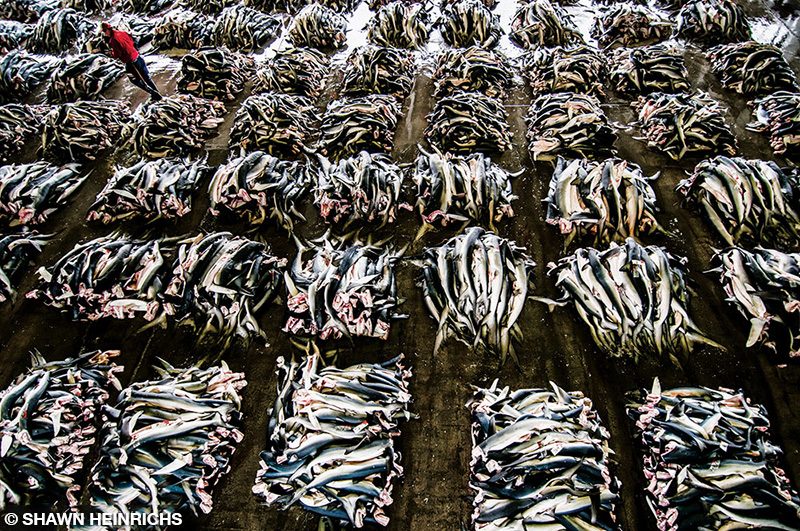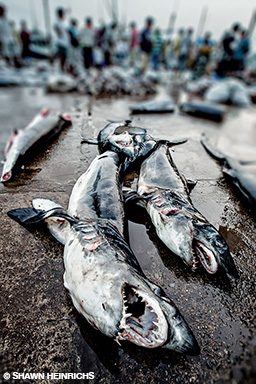These vulnerable sharks get CITES Appendix II protection.
We arrived in the port city of Kesennuma, Japan, under cover of darkness in the early morning hours. This famous fishing port had historically boasted massive catches of tuna but also had significant landings of sharks as bycatch. In recent years, with tuna stocks plummeting, fishers reported that they had turned to sharks as the primary target for their longlines. Just before the sun crested the horizon, we slipped quietly into the huge processing facility and began documenting the landings. What followed was one of the most shocking and grisly scenes we had witnessed in all our years of shark investigations.
We estimated about a dozen commercial tuna-fishing vessels were in port that day with sharks aboard. The ships were tied up at the port and used onboard cranes to hoist their shark catches from the holds. Conveyor belts and forklifts with large bucket scoops transported the sharks to the auction floor. The ships took hours to unload, their holds pouring forth a seemingly endless train of bloodied shark carcasses. Our estimates, later confirmed by a port foreman, put the number landed that day at 6,500 sharks — a staggering figure.

We documented three main species of sharks landed: blue, salmon and mako. We observed far fewer makos (less than 200) than other shark species, and except for a few mature adults, most of the makos we saw were juveniles. Fishers reported that they had previously caught many more and much larger makos, but the number and size had declined precipitously in recent years. That investigation was in 2010, and the fisheries’ pressure on makos has only intensified since then.
My further shark investigations have taken me to ports and markets across the globe, and at each stop I witnessed a similar tragic story unfolding for these vulnerable sharks: precipitous population declines, the disappearance of mature and breeding adults and intensified efforts to catch the last remaining ones. In the dried seafood markets of Hong Kong, shark fin traders even boasted that the value and demand for mako fins had significantly increased in recent years as their fins had become scarcer.
Across the oceans, mako shark populations are in deep trouble. They primarily hunt pelagic fish species such as tuna and marlin, which are heavily targeted by massive international industrial fishing fleets. As such, they are frequently caught as bycatch by these fleets; with decades of exploitation, these fisheries have driven mako populations to the brink. Although the majority of the makos caught on longline gear are still alive when brought on board the vessels, demand for their prized fins and meat continues to drive commercial fishers to choose to kill and retain them.
I have always been fascinated by sharks. As a diver and underwater photographer for almost three decades, I have been blessed to swim with and photograph some of the ocean’s most iconic shark species. In shark hotspots such as the Bahamas, Guadalupe and Fiji, I have spent countless hours in the open water with some of the most feared shark species, including tiger sharks, bull sharks, oceanic whitetips, great hammerheads and even great whites. One shark species, however, had always eluded me: that most formidable and fearsome predator, the mako. There was something about the fastest shark in all the oceans — with its impressive rack of razor-sharp teeth protruding from its powerful jaw, an awesome predator that could chase down a mighty marlin and tear it to shreds in just moments — that triggered an unresolved primal fear buried deep inside me.

When the Convention on International Trade in Endangered Species of Wild Fauna and Flora (CITES) proposed to add both shortfin and longfin mako sharks to its list of protected species, I sprung at the opportunity to help secure their protection. As many as 1 million makos are caught for their fins and meat each year in largely unmanaged fisheries. A female mako takes 18 years or more to mature and has only four to 16 pups every 18 months, making them incredibly vulnerable to overexploitation.
CITES, a United Nations body of 183 parties, is the only international treaty with binding provisions upon member parties to protect threatened and endangered species from unsustainable trade in their body parts. International trade in sharks and rays has led to huge population declines around the globe. A CITES Appendix II listing would afford makos the management and protection that they desperately needed to survive and recover.
Through my imagery and storytelling, I could give makos a voice and help reshape misperceptions about these vulnerable and heavily exploited animals. This was also my opportunity to finally come face-to-face with a shark that had evaded me, interacting on its turf and terms and revealing the true nature of this magnificent species.
My journey took me to Auckland, New Zealand, where I freedived with shark scientist and conservationist Riley Elliott. At first the sharks came in hard and fast, all teeth and pure adrenaline, giving the impression that we would have to be crazy to enter the water. I still get goosebumps when I recall that moment: standing on the swim step, camera in hand, ready to capture a split shot while Riley filmed with his pole cam. A mako turned and charged directly at me, launching out of the water to land her head on the swim step, her razor-sharp teeth within inches of my toes. I understood why these sharks had earned such a fearsome reputation. Exercising patience and drawing on Riley’s deep experience, we persevered and allowed the curious animal to become more comfortable with our presence. Eventually, when Riley signaled it was time, we dropped into the water, and I came face-to-face with my first live mako.

This magnificent predator emerged out of the blue and was bathed in brilliant light. Deliberate in her movements and resolute in her focus, she swam straight at me. As she steadily closed the distance, I was captivated by her striking features: powerful, protruding jaws with rows of formidable teeth; purple and iridescent-blue skin covering a robust, muscular body; tall and rigid dorsal fin; and a powerful tail designed to propel her through the water at astonishing speeds. Here I was, a vulnerable human, floating helplessly in the path of this awesome creature. With less than 3 feet between us, she suddenly slowed and glided up to me, our eyes locking momentarily as her nose gently brushed across my camera dome. My fear immediately metamorphosed into deep appreciation and utmost respect for this impressive predator.
This shark could tear me to shreds in moments, but that was not her intention. She was not a mindless man-eater, but intelligent, highly evolved and selective. She was behaving as millions of years of evolution had conditioned her: establishing her territory, investigating my alien presence and determining whether I was a competitive predator or potential prey. Deciding that I was neither, she settled down and graced us with hours of breathtaking interactions. Over several days an intelligent, curious and cautious animal revealed itself. Through our interactions we succeeded in capturing powerful imagery that exposed the true nature of these magnificent beings and the unique connection between human and shark.
Working in a close coalition of nongovernmental organizations — including Blue Sphere Foundation, SeaLegacy, Lonely Whale, Vulcan, Wildlife Conservation Society, Pew Charitable Trusts, Humane Society International, International Fund for Animal Welfare, Professional Association of Diving Instructors, Nakawe Project and others — we took a stand for makos in August 2019 on the floor of the CITES conference. Harnessing the power of social media, 100,000 concerned global citizens joined the chorus, calling on nations to do the right thing and protect makos. In a vote that came down to the line, the member parties voted to add makos to Appendix II of CITES, a landmark victory to protect such a commercially valuable shark species.
Shawn Heinrichs is the founder of Blue Sphere Foundation.
How You Can Help
Divers can help by doing the following:
- Be a powerful voice for shark conservation in your community.
- Support international, national and state legislation that protects sharks.
- Spend your travel dollars in places that are taking a stand for sharks.
- Contribute to organizations that are working to protect sharks.
- Never consume food or buy products made from sharks.
Explore More
Watch this Shawn Heinrichs video, Mako Shark: King of the Pelagic Realm, to learn more about mako sharks and their need for protection.
© Alert Diver — Q1 2020